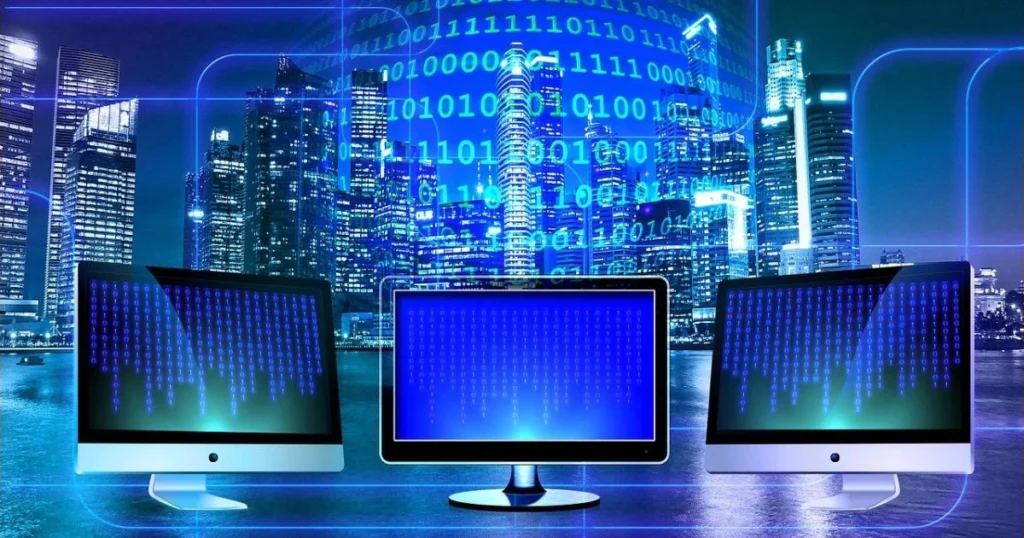
Table of Contents
An operating system (OS) is the core software that powers every electronic device you use. Whether it’s your smartphone, laptop, or smart refrigerator, the operating system acts as the critical backbone of device management. It enables seamless interaction between hardware and software.
Think of an OS like the brain of your digital device. It coordinates complex tasks, manages resources, and creates a user-friendly environment. This is where applications can run smoothly. From Windows and macOS to Android and iOS, these systems control everything from memory allocation to user interface design.
Understanding how OS work can help you make better technology choices. It shows the sophisticated technology behind your everyday devices. By managing hardware resources, running applications, and providing essential user interfaces, operating systems are the unsung heroes of modern computing.
Key Takeaways
- Operating systems are essential core software for digital devices
- They manage hardware and software interactions
- Different devices require specific operating system designs
- Operating systems enable user interaction and application execution
- Resource management is a critical operating system function
What is an Operating System and Why Does it Matter
An operating system is the key software that makes your digital devices work. It connects hardware and software, making it easy for you to use your computer, phone, or tablet.
Operating system functions are key to how well your device works. They handle tasks you might not even notice but are always there. Think of an operating system as your device’s brain, controlling everything.
Core Functions of Modern Operating Systems
Modern operating systems do many important things to keep your device running well:
- Memory management and allocation
- Process scheduling and multitasking
- Device driver coordination
- User interface rendering
- Security protocol implementation
The Hardware-Software Interface
The hardware-software interface is a key part of operating systems. It makes complex hardware instructions easy for software to understand. This lets apps work well with your device’s parts.
| System Component | Primary Function | User Impact |
|---|---|---|
| Kernel | Core system management | Efficient resource allocation |
| File System | Data organization | Easy file storage and retrieval |
| User Interface | User interaction | Intuitive device navigation |
Key Components Working Together
System components work together to make your computing experience smooth and reliable. They manage background tasks and make sure your device looks good. Each part is important for how well your device works.
Understanding these systems shows how advanced technology is in our daily lives.
The Evolution of Operating Systems Through History
The history of OS is a thrilling story of how computers have changed. It shows how we’ve moved from simple batch processing to today’s advanced digital world. This change has greatly influenced how we use technology.
In the early days, computers needed a lot of manual help. Programmers used punch cards to give instructions. They then had to wait for the computer to finish processing. These systems were much slower than what we have today.
- 1950s: Batch processing systems emerge
- 1960s: Time-sharing systems revolutionize computing
- 1970s: Personal computer operating systems develop
- 1990s: Graphical user interfaces become mainstream
- 2000s: Mobile and cloud-based operating systems rise
Important moments in OS history include the launch of Unix in 1969. It set the stage for many future systems. Microsoft’s MS-DOS and Apple’s Macintosh OS made computers easier for everyone to use.
| Decade | Key Development | Impact |
|---|---|---|
| 1950s | Batch Processing | Initial computer automation |
| 1970s | Unix Development | Networked computing foundation |
| 1990s | Windows 95 | Mainstream graphical interfaces |
| 2000s | Mobile Operating Systems | Portable computing revolution |
Today, OS keep getting better. They now use artificial intelligence and better security. They also make it easy to use devices together. Your digital life is thanks to all the hard work in computer system development over the years.
Types of Operating Systems in Today’s Digital World
Operating systems power the digital devices you use every day. They make your laptop and smartphone work smoothly. Different types of systems do this behind the scenes.
The world of OS is complex and diverse. It spans many platforms and devices. Each type has its own purpose and meets specific needs.
Desktop and Laptop Operating Systems
Desktop OS platforms are key in personal computing. Three main systems stand out:
- Microsoft Windows: Most widely used globally
- Apple macOS: Known for sleek design and seamless integration
- Linux: Popular among developers and technical users
Mobile Operating Systems
Mobile OS technologies have changed how we use digital devices. Two platforms lead the market:
- Android: Open-source system powering numerous smartphones
- iOS: Apple’s proprietary mobile OS
Embedded Systems and IoT Operating Systems
Embedded systems and IoT operating systems are at the forefront of technology. They power smart home devices and industrial machinery. They enable digital ecosystems to connect.
- Embedded systems operate in specific hardware environments
- IoT operating systems facilitate communication between devices
- Real-time processing capabilities distinguish these systems
Knowing about these OS types helps us understand modern digital experiences. It shows the complex technology behind them.
How Operating System Manages Your Device’s Resources
When you use your computer or smartphone, a complex system works behind the scenes. The OS acts like a conductor, coordinating hardware to ensure smooth performance. This makes your device work efficiently.
Resource management is key to how your device uses its power. The OS manages several important aspects of performance:
- Memory allocation for running applications
- CPU scheduling to prioritize tasks
- Device driver coordination
- Input/output management
CPU scheduling is vital for multitasking. Your OS decides which tasks get time, making sure important apps run smoothly. This keeps your system responsive.
| Resource Type | Management Strategy | Performance Impact |
|---|---|---|
| Memory | Dynamic allocation | Faster application loading |
| Processor | Task prioritization | Smooth multitasking |
| Hardware | Device driver integration | Seamless peripheral support |
Device drivers are the heroes of resource management. They let your operating system talk to hardware peripherals, making sure everything works well. This includes your printer and graphics card.
Knowing how your OS manages resources is fascinating. It shows the complex tech behind your digital life. From launching apps to running complex software, it ensures your device works well.
Essential Features of a Modern Operating System
Modern OS are key to digital devices, offering more than basic computer control. They provide smooth interactions, strong security, and manage data well.
Operating systems have changed a lot, adding features that improve user experience and protect digital stuff. Let’s look at the main parts that make today’s OS platforms strong and easy to use.
Intuitive User Interface Design
Your user interface is how you interact with your device. Modern OS focus on making interfaces easy to use and look good. They have:
- Graphical user interfaces (GUIs) that respond well
- Customizable desktops
- Easy navigation and icon use
- Layouts that work on different screens
Comprehensive OS Security
OS security is now very important to keep your digital world safe. Today’s operating systems have many protections to keep your data safe and stop unauthorized access:
- Multi-factor authentication
- Malware detection in real-time
- Encrypted file storage
- Automatic security updates
Advanced File Management
Good file management and storage are key for a tidy digital space. Modern operating systems have tools that make working with files easier:
- Smart file organization
- Cloud syncing
- Control over who can access what
- Fast search and find functions
These features show how operating systems have grown from simple software to full digital management tools. They focus on making things easy, secure, and productive.
Common Operating System Tasks You Use Daily
Your operating system handles many tasks every day. It keeps your digital world running smoothly. These tasks include file operations and system settings, making sure your device works well and meets your needs.
File operations are key. Your OS offers tools to manage your digital files. You can:
- Create new files and folders
- Move, copy, and delete documents
- Organize files with intuitive search and sorting functions
- Compress and extract file archives
Managing applications is also important. Modern OSs make it easy to install, update, and remove software. With a few clicks, you can:
- Download applications from verified stores
- Update software automatically
- Manage application permissions
- Uninstall programs completely
System settings let you customize your computer. Personalization is key to making your device your own. You can change display settings, set up network connections, manage user accounts, and improve performance with built-in tools.
“Your operating system is the command center of your digital life, turning complex technological processes into simple, user-friendly interactions.”
Knowing about these tasks makes you more confident and efficient online.
Operating System Security and Updates
Keeping your digital world safe needs a proactive plan for OS updates and cybersecurity. Your operating system is your first defense against digital threats. It’s key to managing your device.
Today’s operating systems have strong protection to keep your data safe and your system running well. It’s important to stay ahead of security risks. This means knowing the value of timely updates and strong protection plans.
Importance of Regular Updates
OS updates do more than just tweak your system. They bring big benefits:
- Patch security vulnerabilities
- Improve system performance
- Add new features and functionality
- Enhance compatibility with latest software
Protection Against Cyber Threats
Cybersecurity is a never-ending fight. Your operating system has many defenses to fight off threats:
- Built-in firewalls that monitor network traffic
- Advanced virus and malware detection
- Secure boot processes
- Automatic threat scanning
Backup and Recovery Options
Data backup and system recovery are vital for OS security. Protecting your valuable information requires a comprehensive approach:
- Automatic cloud backup systems
- Local system restore points
- Encrypted backup solutions
- One-click system recovery
By using these security steps, you can keep your device safe. Your data will be secure, and your OS will run smoothly.
Choosing the Right Operating System for Your Needs
Choosing the right OS is important. It depends on what you need from your device. Different systems meet different needs and preferences.
When looking at compatibility, think about a few things:
- Hardware specifications
- Software application needs
- Personal workflow demands
- Budget constraints
Popular systems like Windows, macOS, and Linux have their own benefits. Windows is great for software compatibility. macOS works well with Apple devices. Linux is for those who like to customize.
Think about what you need most:
- Performance requirements
- User interface comfort
- Security features
- Long-term system support
Professionals might choose Windows or macOS for work. Graphic designers often go with macOS. Developers like Linux for its flexibility and development tools.
No single system is perfect for everyone. Look at your needs, try out different systems, and pick the best one for you.
Conclusion
Operating systems are key in our digital world. They are the backbone of every device we use every day. From phones to servers, they manage resources and keep our devices safe.
The future of OS is exciting. New technologies like AI and quantum computing will change how we use them. These advancements will make our devices smarter and more connected.
Knowing about OS is important for everyone. It helps you make smart choices about your digital life. As technology gets more complex, understanding operating systems will become even more crucial.
Technology keeps getting better, and operating systems will lead the way. By keeping up with these changes, you can use technology to be more productive and creative. This is true for both work and personal life.




